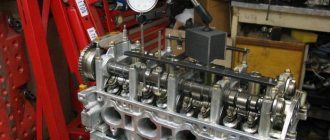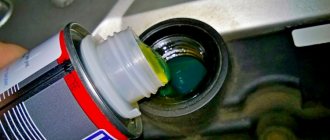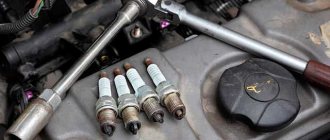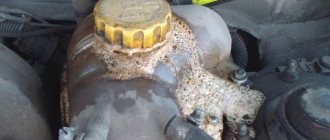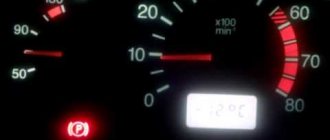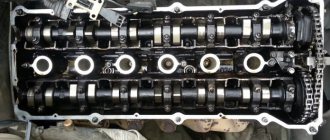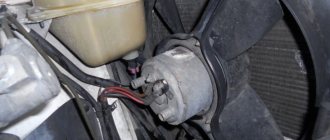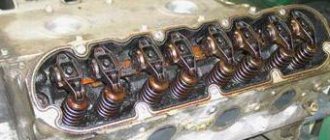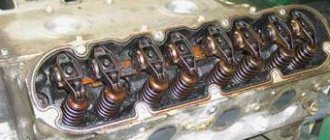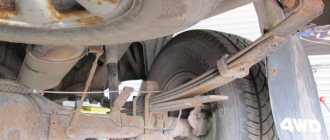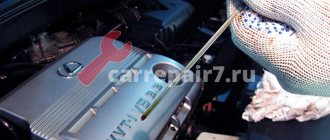One of the first internal combustion engines with hydraulic compensators was installed on a Cadillac car back in the 30s of the last century. But “hydrikis” became truly in demand only decades later, largely due to the expansion of the Japanese automobile industry. Their use in the operation of the gas distribution mechanism (GRM) led to the complication of engine design, but also significantly simplified maintenance.
- What is this
- Why is it needed?
- How does it work
- Why is it knocking?
- How to check
- How to prevent breakdown
Camshaft location
Modern cars most often use a mechanism with an overhead camshaft, which has reduced the metal consumption of the structure and, as a result, increased reliability.
Since metal expands when heated, and the valves are constantly in a high-temperature zone, to prevent it from being pressed in, as a result of which it does not fit tightly into the seat, a thermal gap is provided between the valve stem and the camshaft cam.
In this case, the thermal gap has a certain value to ensure the maximum possible opening of the valve, eliminating its tightening.
Previously, on engines with an overhead camshaft, the thermal clearance was adjusted by placing shims of a certain thickness between the valve stem and the camshaft cam.
The disadvantage of using these washers was the need to periodically check the gap and adjust it by selecting washers.
Nowadays, to ensure thermal clearance, hydraulic compensators are increasingly being used, popularly known as hydraulic compensators, the use of which eliminated the need to adjust the gap, and all because the gap is adjusted by oil pressure.
Hydraulic compensators, like shims, are located between the valve stem and the camshaft cam.
Externally, the hydraulics look like a small piston, so the head has seats for them.
The role of hydraulic compensators in engine operation
Hydraulic compensators are necessary to compensate for the thermal gap in the valve drive mechanism. The need for a thermal gap arises due to the different coefficient of thermal expansion of the cylinder head parts. The design of many internal combustion engines does not include hydraulic compensators. Instead, adjusting cups are installed, with the help of which the thermal gap is adjusted. This technology is more reliable, but requires periodic maintenance.
Hydraulic compensators allow you to ensure minimal valve drive clearances throughout the entire temperature range of engine operation and do not require regular adjustment.
Design and operating principle
The design of the hydraulic compensator itself is simple. It consists of a cylindrical piston, the bottom of which receives the force from the camshaft cam.
Inside this piston, a plunger is installed in its seat, through which force is transmitted through the piston from the cam to the valve stem (see photo above).
The plunger moves freely in its seat, providing a thermal gap.
The hydraulic valve works like this: when the engine is running, the cam runs up against the bottom of the hydraulic compensator piston and moves it down. While moving, the piston presses on the valve through a plunger, and it opens.
The gap is adjusted using oil.
The oil pump supplies working fluid to the head under pressure. In the hydraulics, it enters the space below the plunger and displaces the plunger inside the seat.
The higher the oil pressure, the more it will put pressure on the plunger and the more it will come out of its seat.
When the pressure decreases, the plunger enters the seat again. Thus, the thermal gap between the plunger and the valve stem is independently regulated and depends on the pressure in the lubrication system.
To prevent oil from flowing out of the hydraulic compensator after stopping the engine, ball valves are installed in the oil supply channels in the cylinder head.
Having the advantage of no need for adjustment, the hydraulic compensator also has one significant drawback - high sensitivity to engine oil.
Why is the hydraulic compensator knocking?
A faulty compensator makes short, sharp and frequent sounds, similar to metallic crackling. Since the working medium of the hydraulic compensator is engine oil, its quality affects the durability of the device.
1. Causes of knocking compensators related to engine oil:
- The use of so-called dirty oils, in which there are insufficient detergents and dirt-retaining additives, and the acidity level is higher than alkaline. The heating temperature of timing parts reaches 800⁰C. Poor quality oil leads to the formation of carbon deposits, which disrupts the operation of the moving parts of the compensating device.
- The engine oil level is below (above) normal. If the oil is more than normal, then as a result of oil foaming in the crankcase, air gets into it. If the level is low, the oil pump is entraining air as it supplies oil to the hydraulic compensator. The knocking noise is heard only at high engine speeds, and is absent at idle and low speeds.
- Oil pump malfunction. Oil flows slowly or not at all to the hydraulic compensator.
- Untimely replacement of engine oil and oil filter. Dirt in the oil leads to clogging of the gaps between the body and the plunger, “sticking” of the ball in the valve seat and, as a result, to loss of mobility of the plunger.
- Clogged oil passages of the cylinder head.
When applying for compulsory motor liability insurance, you will be required to provide a vehicle diagnostic card. What is it and where to get it - see our material.
Our other article will tell you how to defrost the washer reservoir in several simple ways.
2. Mechanical causes of knocking:
- Check valve malfunction. The hydraulic compensator knocks when cold, immediately after starting the engine, but the sound disappears as the speed increases. The same thing happens on a warm engine, when the knock disappears when you press the accelerator pedal.
- Defects in the surfaces of the body and plunger (scores, dents, gouges). A characteristic knock is heard regardless of the speed of rotation of the timing camshaft.
- Wear of the plunger pair. In this case, the knocking noise appears when the engine is warmed up. When the engine has cooled down again, there is no knocking noise.
What are the consequences of operating an engine with faulty hydraulic compensators?
The knocking of compensators is a signal that the thermal clearances in the timing system are not respected, although at first there is no danger to the engine. It’s a different matter if you don’t take any action and continue to use the car for a long time. In this case, breakdown of the gas distribution mechanism is inevitable. The camshaft cams and associated timing parts are the first to suffer from the resulting shock loads when starting the engine.
Causes of knocking hydraulic compensators
The hydraulic compensator is still not an adjusting washer, which can only decrease in thickness due to constant friction; it may well fail.
Problems with the operation of the hydraulics manifest themselves in the form of a clearly audible knocking sound during operation of the power plant. Moreover, the knocking may occur in some engine operating modes, but in others it disappears.
Also, the knocking of hydraulic compensators can appear when the engine is not warmed up and disappear after reaching the optimal temperature, or vice versa.
The most common cause of hydraulic knocking is engine oil, although there are quite a few other causes.
If, when starting the power plant, a knocking sound is heard from the hydraulic compensators, but it quickly subsides, this is not the reason for their failure.
It’s just that after the next stop of the power unit, some of the valves remain squeezed out due to the location of the camshaft, the oil supply channels also remain open and the working fluid from the hydraulic fluid flows through them.
When starting, the amount of oil in the channels is quickly replenished.
But if knocking on a cold engine continues for a long time or until the engine is completely warmed up, this indicates a malfunction.
The hydraulic compensator knocks when cold.
Knocking when cold may indicate:
- Mechanical wear of the plunger and its seat. In this case, the working fluid does not maintain its pressure and constantly flows out of the sub-plunger space;
- Jamming of the plunger in the seat due to contamination;
- Ball valve jamming in the open position due to contamination;
- Oil supply channel clogged. When warmed up, the blockage is washed out by flowing oil and the hydraulic compensator works normally;
- Use of high viscosity oil in cars. When the engine is running cold, viscous oil simply does not have time to enter the hydraulic compensator;
- Exhausted oil life, as well as significant contamination with friction products;
- Significant clogging of the oil filter, as a result of which its throughput drops, and cold oil is not supplied in full to the cylinder head.
The reasons for the knocking of hydraulic valves on a cold engine are in many ways similar to the reasons for their knocking on a hot one.
Knock of the hydraulic compensator on a hot engine.
The appearance of a knock may be due to mechanical wear, jamming of the plunger or valve.
Regarding the oil, it is worth noting that knocking when hot can be due to highly fluid oil, then the oil pump cannot provide the proper pressure.
Another reason for knocking, both cold and hot, may be wear of the oil pump with a subsequent drop in its performance.
How do hydraulic compensators knock?
The knocking sound of hydraulic compensators resembles a clatter, very similar to the clatter of a loose chain. It comes from the cylinder head. From its top. The knocking of expansion joints can occur when it is cold or hot, or it can always be present, depending on the wear of the expansion joints.
As we know, the operation of hydraulic compensators is directly related to oil. When the engine is cold, the oil simply has not yet entered the hydraulic compensators, so the engine may make a characteristic clicking noise for some time. But after a short time, if there are no other prerequisites, the knocking will disappear.
This symptom is very clearly observed on domestic classic engines that are installed in Nivas of recent years of production. At one time, the happy owners of these engines wrote a collective letter to the VAZ company and demanded a recall company.
Consequences of the knocking sound
It is interesting that the breakdown of hydraulic compensators does not lead to any damage to other mechanisms of the power plant.
For knocking hydraulic compensators, the thermal clearance is simply disrupted, which only leads to a decrease in the power and throttle response of the power plant and an increase in fuel consumption.
But a knocking sound may indicate a malfunction in the lubrication system, so it is important to find out why they are knocking and fix the problem.
As for the use of SOHC and DOHC gas distribution systems on cars, the only difference is in the number of installed hydraulic compensators.
Thus, modern cars, including domestic ones, for example, VAZ 2112 and Lada Priora, already use a DOHC gas distribution system, with 4 valves per cylinder, and therefore with 4 hydraulic valves, the total number of which is 16.
The reasons for the knocking sound for all cars, including those mentioned, are the same.
The presence of such a number of hydraulic valves only makes it more difficult to identify a knocking hydraulic compensator if only one or several of the total number is knocking.
Severe mechanical wear
If the car has high mileage and the hydraulic compensators have not been changed for a long time, knocking noise from them may be due to excessive wear.
A visual inspection will help you understand how to identify a knocking hydraulic compensator. If the impact surface is worn, the knocking hydraulic compensator will be visible immediately by the dents from the camshaft. If all the hydraulic compensators look normal outwardly, you need to press them one by one with a piece of wood or a screwdriver. The effort should be the same. In this way, you can identify both a jammed hydraulic compensator and one that is not holding pressure.
Identifying faulty hydraulic compensators
In principle, it is not difficult to identify a knocking hydraulic compensator. It is enough to remove the valve cover from the car to gain partial access to them, which will be enough for checking.
To check the hydraulics, it is enough to use a thin wooden block.
The check is carried out by pressing on the bottom of the hydraulic valve. When force is created, it will begin to sink into its seat. When checking, it is important that the camshaft cam does not act on the bottom of the hydraulic valve.
A jammed hydraulic compensator will simply not be recessed into the seat by the created force; human impact will not be enough to overcome the forces of the valve spring.
If there is no oil in it for any of the listed reasons, the hydraulic valve will be recessed into the seat with significantly less force than when working normally.
Using this method, you can calculate broken hydraulic compensators.
Diagnostic and repair methods
To check the hydraulic lifters, you need to remove the valve cover. The cam of the hydraulic compensator being tested should be facing its body with the back side (pressure is not applied). Since none of the service documentation indicates what pressing force of the hydraulic pusher is considered normal, you need to carry out the procedure with all hydraulic modules. Using the comparison method, even without experience in repairing internal combustion engines, you can identify a faulty hydraulic compensator.
Some people manage to eliminate the knocking of hydraulic compensators by washing them, removing carbon deposits and varnish deposits from the internal surfaces.
But it is worth noting that not all types of structures are amenable to such repairs. Since the procedure for replacing hydraulic cylinders is quite expensive, we recommend installing exclusively new hydraulic cylinders instead of faulty ones. Manufacturers do not provide spare parts for repairing hydraulic modules. Seal
Typical faults
Before examining the removed hydraulic compensator, you need to identify the non-functioning element. Compensators are located on the valves, so their number is equal to the number of valves provided on the engine.
The check can be done without removing the camshaft. But first you need to understand why even new elements fail. There are 4 main faults.
- The gap provided between the plunger itself and its bushing increases. As a result, oil will begin to leak. The compensator will not be able, so to speak, to select thermal gaps;
- The valve does not close properly. This happens rarely, but it should not be ruled out. Because of this, the required pressure cannot be created between the plunger and the bushing;
- Jamming of the plunger pair. The way the sleeve works is that it should move freely relative to the installed plunger. If this freedom is not there, hello jamming;
- Blockages. Oil channels become dirty. Therefore, hydraulic compensators (HC) cannot work.
There is a fairly extensive list of video and photo guides that you can use to check.
It is important for the motorist to tell which of the existing main engines is knocking in order to repair it, replace it and restore normal engine operation.
It is worth noting that some cars do not have hydraulic compensators. So a slightly different technology is provided.
Most often, motorists ask such questions as owners of the following cars:
- Gazelle;
- Chevrolet Lanos;
- Volkswagen Polo;
- Lada Priora 16 valves;
- Daewoo Nexia 8 valves;
- Chevrolet Niva;
- VAZ 2110;
- Lada Kalina;
- Nissan Almera, etc.
It doesn't matter what kind of car or engine you have. You may have a ZMZ 406 motor at your disposal, or the malfunction has occurred on a VAZ 2112. Despite the slight difference in designs, the main engines are checked and repaired in approximately the same way. There are no significant differences.
When starting work, first make sure that you know where the compensators are located and what to do if a faulty element is identified.
How to remove knocking
A knocking hydraulic compensator does not always need to be replaced with a new one. If a characteristic knocking noise appears, first of all, you need to change the oil and oil filter. Sometimes this procedure is enough and the noise disappears.
You can use special flushes of the lubrication system. With the help of modern developments from leading brands, it is possible to wash not only contaminated, but also coked oil channels.
Oil channels must be periodically flushed with special liquids.
The most effective is mechanical cleaning of hydraulic compensators. The hydraulics are removed, disassembled, cleaned and washed.
Is it possible to drive with knocking hydraulic lifters?
Many drivers are interested in the question of whether it is possible to drive with knocking hydraulic compensators and what consequences this can lead to. Let's answer it right away - it is possible, but it is not advisable, since the car will be plagued by a number of problems . In particular:
- loss of power;
- loss of control elasticity (the car will respond worse to steering);
- unenvironmental friendliness (unhealthy exhaust plume from the rear);
- excessive fuel consumption may occur;
- increased vibration;
- additional noise under the hood.
Accordingly, during the operation of a faulty engine there is a chance to “finish off” it completely. Therefore, it is strictly not recommended to drive with faulty engine components. After all, sooner or later it will fail. And the sooner you start repair work, the cheaper and easier it will cost you.
Obtaining loans secured by PTS: how it works
- In summer, winter oil is used;
- In winter, summer lubricant is used;
- the compensator has failed;
- The main body is damaged;
- there is severe wear on the compensator;
- the oil filter is clogged;
- pressure reducing valve is broken;
- The oil pump (pump) is not working correctly.
There is nothing difficult in checking the performance of elements such as hydraulic compensators. The work can be done with your own hands in standard garage conditions.
But whether to eliminate the identified causes yourself or not is a much more serious question. I recommend thinking twice before getting into the engine with your own hands. It's not as simple as it might seem. If you are confident in your abilities, then go for it.
What you definitely shouldn’t do is continue to operate your vehicle when there are obvious knocking noises in the hydraulic compensators. If you ignore this advice, you will face even more serious and costly breakdowns.
Thank you all for your attention! Subscribe, ask questions and stay with us! It wouldn’t hurt to invite your friends to join us either!
